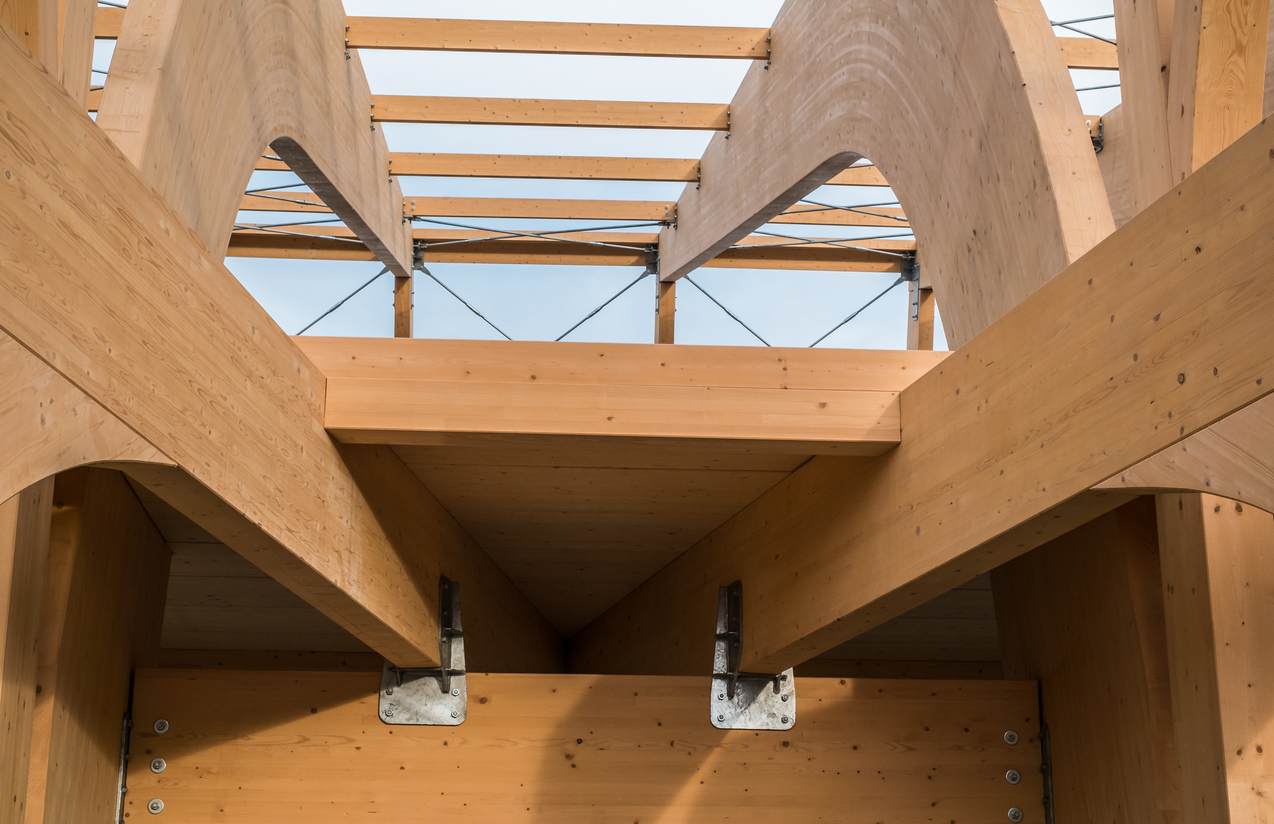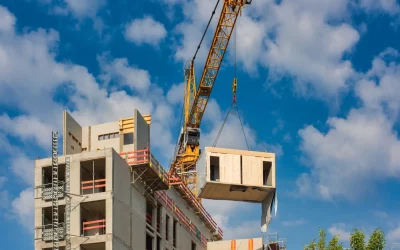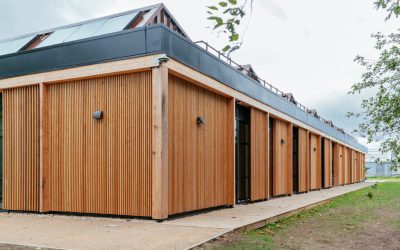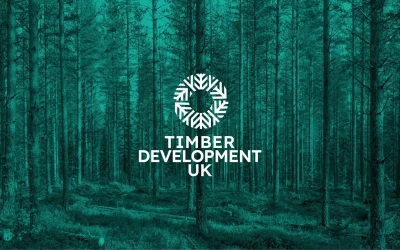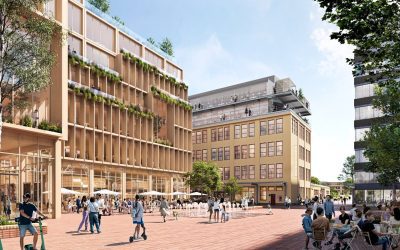Written by Wood Campus
Environmental | Industry | News
Expert urges solid risk management foundation.
Demand for mass timber, a sustainable construction alternative, has grown steadily over the past several years. However, a new trend is driving risks for the construction sector: mass timber being used for taller buildings, not just residential structures.
According to one expert, this shift is observed in Europe, Asia, and North America. Michael Bruch (pictured), global head of Risk Advisory Services at Allianz Commercial, noted that the increasing adoption of mass timber for higher-rise construction indicates a broader acceptance of the material beyond traditional low-rise buildings.
“The emergence of mass timber as a sustainable construction alternative represents a significant opportunity for the building sector to reduce its carbon footprint while also satisfying a demand for a more cost-efficient material but as durable as steel and concrete,” said Bruch.
“However, in any industry, deployment of new materials or processes can result in new risk scenarios, potential defects, or unexpected safety consequences, as well as bringing benefits, and mass timber is no different.”
Construction’s shift to mass timber – what are the most significant risks?
Bruch pointed to Allianz Commercial’s recent report on the risks posed by mass timber. According to the report, the construction sector is responsible for almost 40% of global CO2 emissions caused by concrete, steel, and fossil fuel-driven energy consumption.
Shifting to mass timber, a more cost-efficient material as durable as concrete and steel, allows the construction industry to lower its tremendous carbon footprint. Mass timber emits significantly less CO2: around 50% less than concrete and more than 25% less than steel, Allianz Commercial said in its report.
However, the potential risks associated with mass timber construction are significant, particularly regarding fire hazards and natural calamities.
“The good news from our research is that you can manage these risks,” Bruch said.
Fire is potentially the top risk of mass timber construction. Fire stands as the most expensive cause of all construction and engineering insurance losses, accounting for more than a quarter (27%) of the value of 22,000 claims analyzed over a five-year period, according to Allianz.
To mitigate this risk, Bruch emphasized proactive measures such as designing for fire resistance, using flame-retardant materials, and implementing proper construction practices.
He also noted that while natural hazards vary by region, the resilience of mass timber structures shouldn’t be underestimated.
“Natural catastrophe risks like hurricanes and gale-force winds can potentially affect beams, columns and panels. But mass timber is really strong,” said Bruch.
“Mass timber buildings weigh approximately only one-third of comparable concrete structures, and they have the highest strength-to-weight ratio, which enables mass timber to perform very well during seismic activity.
“Natural hazards can differ from region to region, but those risks can be managed well for mass timber buildings.”
Additionally, construction businesses face supply chain and labor exposures as mass timber demand grows. Mass timber must be obtained in sustainable ways, necessitating specialized production facilities.
“This means thorough logistical planning and management of building materials are essential to avoid costly project delays,” said Bruch.
“On top of that, construction firms may face challenges finding experienced workers for mass timber construction projects. But overall, mass timber buildings can be constructed faster than traditional buildings, so that’s a big pro that we’re seeing.”
Insurance implications for the construction industry as mass timber use expands
The global mass timber market is still in its nascency, but it has tremendous growth potential, according to Allianz Commercial.
Despite the risks involved, Bruch is optimistic about the potential of mass timber to meet sustainability goals and lower emissions. At the same, effective risk management practices and industry collaboration are needed to ensure the widespread adoption of sustainable construction materials and technologies.
Brokers and insurers can help construction clients transition to sustainable materials and technologies by providing risk management solutions and investment incentives.
Bruch stressed that each mass timber building is unique and presents specific risks that must be assessed and managed throughout its lifecycle.
“Given this market’s expected future growth, companies should do all they can to develop a greater understanding of their exposures, including fire, water damage, repetitive loss scenarios and even termite infestation, and ensure they have robust loss prevention measures to combat these,” said Bruch.
READ MORE: Orginal Article: Insurance Business
More News
Government commits to more timber construction
The Government has set out an ambitious plan to raise the use of timber in the construction of homes and buildings. It has published a roadmap to boost the safe use of sustainable UK timber in construction while planting forests to increase domestic timber supply. By...
8 Billion Trees
Wood Campus is always keen to promote content and resources which we know will be of interest to our regular visitors and this is why we are drawing your attention to the 8 Billion Trees mission.8 Billion Trees is dedicated to reducing carbon emissions using tree...
TDUK market forecasts at London conference
UK and international timber traders gathered in strong numbers for Timber Development UK’s Global Market Conference in London on Wednesday at a time of difficult market dynamics. A noticeably downbeat market sentiment was palpable at the event held in Carpenters Hall,...
Learning Through Timber
The new ‘living lab’ at NMITE will act as a home for Centre of Advanced Timber Technology students to learn more about timber and a net zero approach to building materials.A new purpose built 2,500sqm ‘living lab’ for the New Model Institute for Technology and...
World’s tallest wooden building to be built in Perth after developers win approval
Artist’s impression. Photograph: Elenberg FraserDevelopers say South Perth’s C6 building will be made up of 42% timber and be carbon negative Western Australia is set to become home to the world’s tallest timber building, a “revolutionary” 50-storey hybrid design...
The UK continues to embrace timber-based construction
The UK’s three largest housebuilders (Barratt Developments, Taylor Wimpey, and Persimmon) have announced plans to open dedicated factories for timber-based construction materials. Klober is a roofing accessories provider looking to convince construction companies to...
ARUP – Seven perspectives on the use of timber in building design and construction
ARUP are a global collective of designers, consultants and experts dedicated to sustainable development. We use technology, imagination and rigour to shape a better world. For over 75 years, Arup has been recognised for its vision, talent and tenacity. Dedicated to...
Timber Development UK and Structural Timber Association sign MOU
Timber Development UK (TDUK) and Structural Timber Association (STA) have signed a Memorandum of Understanding (MOU) to help grow and develop the timber construction market. Under the terms of the agreement the two parties have agreed to form a partnership in order to...
Worlds largest wooden city Stockholm
Scandinavian studios Henning Larsen and White Arkitekter are designing Stockholm Wood City, which will become the world's largest mass-timber development and have the "serenity of a forest". Set to be built in the Stockholm neighbourhood of Sickla, the project was...
Data & the Three Pillars of Sustainable Forestry
According to Rolf Schmitz, co-founder and co-CEO of CollectiveCrunch and the creator of Linda Forest software solutions, digitising the world’s forests is essential to understanding and fighting climate change. If a tree falls in the forest, it hardly matters if it...

